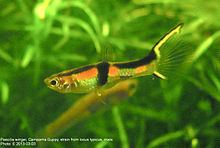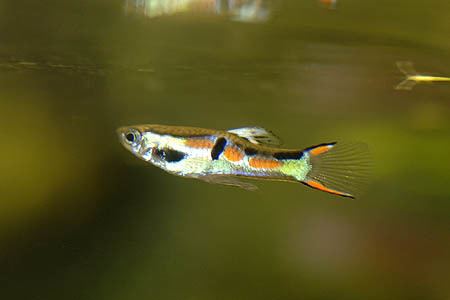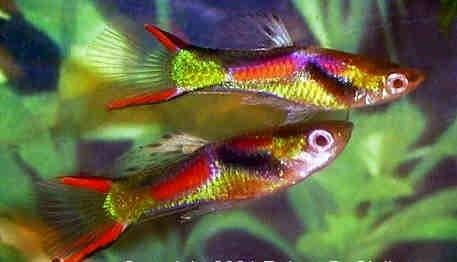Higher classification Poecilia Rank Species | Scientific name Poecilia wingei Phylum Chordata | |
 | ||
Similar Poecilia, Guppy, Southern platyfish, Green swordtail, Poecilia vetiprovidentiae | ||
Poecilia wingei, known to aquarists as the black-bar Endler or Endler's livebearer, in the genus Poecilia, is a small fish native to the Paria Peninsula in Venezuela. They are proficient breeders and often hybridize with guppies. These very colorful hybrids are the easiest to find being offered in pet-shops, typically under the name Endler's guppy.
Contents
- Endler s poecilia wingei livebearers tropical fish for freshwater aquariums
- History
- In the aquarium
- Breeding
- Hybrids
- References

Endler s poecilia wingei livebearers tropical fish for freshwater aquariums
History

Poecilia wingei is a very colorful guppy species, similar to the fancy guppy often found in pet shops. The species was first collected from Laguna de Patos in Venezuela by Franklyn F. Bond in 1937, and rediscovered by Dr. John Endler in 1975. The latter were the first examples of this fish to make it to the aquarium trade. More have been collected since then, notably by Armando Pou, to expand the captive breeding stock. The original Laguna de Patos population is threatened by runoff from a municipal garbage dump. Though it is rare in pet shops, this species is seen occasionally in the aquaria of enthusiasts.

Although not yet taken up into the IUCN Red List of endangered species, they are in danger of extinction in the wild, as humans enter their natural habitat, polluting and destroying it.
According to Stan Shubel, the author of Aquarium Care for Fancy Guppies, the Endler guppy is, in fact, not a separate species; claiming it has the same genetic makeup as the common guppy, yet is given its own name, Poecilia wingei, for conservation purposes. However, in 2009 S. Schories, M. K. Meyer and M. Schartl published on the basis of molecular data that Poecilia wingei is a separated taxon at the species level from P. reticulata and P. obscura.
In the aquarium

Endler's livebearers are hardy and undemanding in the aquarium, though they prefer hard, warm water. The warmer the water, the faster they will grow; however, this also seems to shorten their lifespans. They can be kept at 18–29°C (64–84°F), but their optimum temperature seems to be 24–27°C (75-81°F). This is slightly higher than their guppy cousins, which prefer 23–25°C (73-77°F). They do best if kept in tanks with plants (preferably live plants, but fake will do) to give them hiding places and (although they may be less likely than guppies to eat their own young) give the fry a better chance at survival. Some of them are determinedly suicidal jumpers, so a cover on the tank is a must.

Endler's may be fed any of a variety of dried, frozen, or freeze-dried foods, as long as the food will fit into their relatively small mouths. They are particularly fond of frozen bloodworms, and will often attempt to consume worms nearly as long as they are.
Endler's are very responsive to light and movement. After they learn that humans equate to food, human movement will trigger frantic "begging", regardless of whether the fish are actually hungry or not. Darkness will signal it is time to sleep. Most Endler's will sink to the bottom of the tank and lie there until the light returns, although in community tanks with larger fish that inhabit the depths, some Endler's will "sleep" near the top.
Breeding
The colors of Endler's livebearer males are very intense, especially the black, orange, and metallic green colors. Their natural patterns are highly variable, though many display a double sword tail. Breeders have developed numerous lines displaying specific patterns and colors, such as red chest, black bar, peacock, yellow sword, etc.
They are prolific breeders like their guppy relatives. They give birth to live young approximately every 23 days. Fry "drops" can range in size from one to 30 babies (or possibly more, depending on several variables, including the age and size of the mother). Their first few hours of life will primarily be spent on the bottom of the tank, where they consume their yolk sacs. At this time they are most vulnerable to predators, including their own mothers and other Endler females (males seem less interested in cannibalism).
The fry can be fed powdered fry food, baby brine shrimp, and crushed flake food. They will also nibble on the layer of algae and microorganisms that forms on aquatic plants. Even adult brine shrimp are not beyond their capability, as several fry will gang up on a brine shrimp their own size and tear it apart.
The males will start to show color in approximately three to four weeks, but it can be several months before they develop the full depth and richness of color that characterizes Endlers. The colors of a male Endler will gradually intensify over the first six months of their lives. Tail extensions similar to that seen in a swordtail are not uncommon, but are much shorter. Most often, what appears to be a sword extension can be seen as intense coloring along the edge of an otherwise transparent tail. While giving the impression of a sword it turns out to just be good coloring.
Females will spend their entire lives with rather unexciting coloring. Depending on their environments, females will range from a pale silver to a dull, dark gold, but have the ability to change their coloring somewhat if they are moved from a light environment to a dark one (or vice versa). When full-grown, adult females can be as much as twice the size of males.
The birth process can be stressful for the females, and some will not survive long after large births. The ones that do not do well will often turn grey and will start to "wither away" until they eventually die.
Hybrids
Endlers (P. wingei) can be crossed with guppies species (P. reticulata, P. obscura guppies), and the hybrid offspring will be fertile. This is considered to dilute the gene pool and therefore is avoided by fish breeders who wish to maintain pure strains. Many fish sold in pet stores as Endler's livebearers or Endler's guppy are actually these hybrids. In addition, as P. reticulata has been found in the same bodies of water as P. wingei, natural hybridization may also occur in the wild.
Some hybrids have been selectively bred and have become so common that they may be sold under any number of names such as peacock, snake, tiger, paradise, fancy, or sword Endler and sometimes as flame tail.
